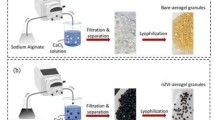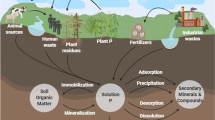Abstract
A novel technology for lead removal with nonliving Rhizopus oligosporus immobilized in calcium alginate was studied. The results show that the main influencing factors include pH value and interfering cations. pH value has different effects on biosorption of various heavy metals and lead adsorption can be proceeded by controlling pH value in a range of 2–5; interfering cations especially Cu(II) can make the adsorption amount of Pb(II) decrease by immobilized Rhizopus oligosporus. Desorption efficiency of different eluants and kinetics were investigated. Citrate acid with concentration of 0.3 mol · L−1 is the best for the elution of Pb(II) and desorption rate is over 98% when the reaction equilibrium reaches 3 h. Immobilized biomass keeps high lead biosorption capacity after five cycles of regeneration.
Similar content being viewed by others
References
GB8978-88. Standard of Wastewater Discharge [S]. China Environmental Protection Agency, 1988.
Vinta V P, Radhanathp D. Biosorption process for removing lead(II) from aqueous effluents using Pseudomonas SP[J]. Int J Environ Studies, 1994, 46(4): 243–250.
Nourbakhsh M, Sag Y, Ozer D, et al. A comparative study of various biosorbents for removal of chromium (VI) ions from industrial waste water[J]. Process Biochemistry, 1994, 29(1): 1–5.
WANG Y, ZHANG L, YU Y T. Accumulation of lead ion from aqueous solution by microbiologic biomass[J]. Environmental Science, 1998, 19(3): 62–65.
Aksu Z, Kutsal T. A bioseparation process for removing lead(II) ions from waste by using C. vulgaris [J]. J Chem Technol Biotechnol, 1991, 52(1):109–118.
Jiri Gabriel, Jan Vosahlo, Peter Baldrian. Biosorption of cadmium to mycelia pellets of wood-rotting fungi[J]. Biotechnology Techniques, 1996, 10(5): 345–348.
David Kratochvil, Patricia Pimentel, Bohumil. Removal of trivalent and hexavalent chromium by seaweed biosorbent[J]. Environ Sci Technol, 1998, 32(18): 2693–2698.
Lee C K, Low K S, Kek K L. Removal of chromium from aqueous solution[J]. Bioresource Technology, 1995, 54(2): 183–189.
CHANG J S, HONG J. Biosorption of mercury by the inactivated cells of pseudomonas aeruginosa PU21 (Rip64)[J]. Biotechnology and Bioengineering, 1994, 44(8): 999–1006.
Phiip L, Lyengar L, Venkobachar C. Biosorption of copper(II) by pseudomonas aeruginosa[J]. Int J Environment and Pollution, 1995, 5(1): 92–99.
Gadd G M. Fungi and yeasts for metal accumulation [A]. Ehrlich H L, Brierley C L. Microbiol Mineral Recovery[C]. NewYork: McGraw-Hill Publishers, 1990. 249–275.
Sahoo D K, Kar R N, Das R P. Bioaccumulation of heavy metal ions by Bacillus circulans [J]. Bioresource Technology, 1992, 41(2): 177–179.
Sag Y, Kutsal T. Biosorption of heavy metals by Zoogloea ramigera: use of adsorption isotherms and a comparison of biosorption characteristics[J]. The Chemical Engineering Journal, 1995, 60(1–3): 181–188.
Anoop Kapoor, Viraraghavan T, Cullimore D R. Removal of heavy using the fungus Aspergillus niger[J]. Bioresource Technology, 1999, 70(1): 95–104.
Author information
Authors and Affiliations
Corresponding author
Additional information
Foundation item: Project (2001-39) supported by Excellent Young Teachers Program of Ministry of Education of China
Rights and permissions
About this article
Cite this article
Yu, X., Chai, Ly. & Min, Xb. Removal of lead in wastewater by immobilized inactivated cells of Rhizopus oligosporus . J Cent. South Univ. Technol. 10, 313–317 (2003). https://doi.org/10.1007/s11771-003-0030-x
Received:
Accepted:
Issue Date:
DOI: https://doi.org/10.1007/s11771-003-0030-x




